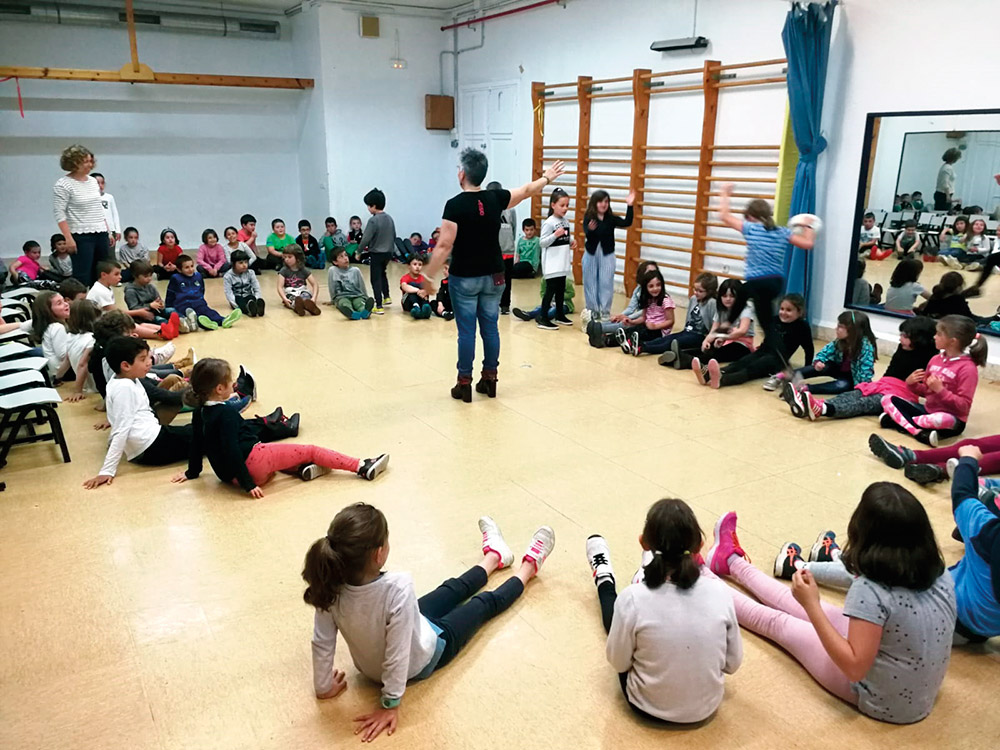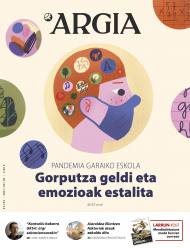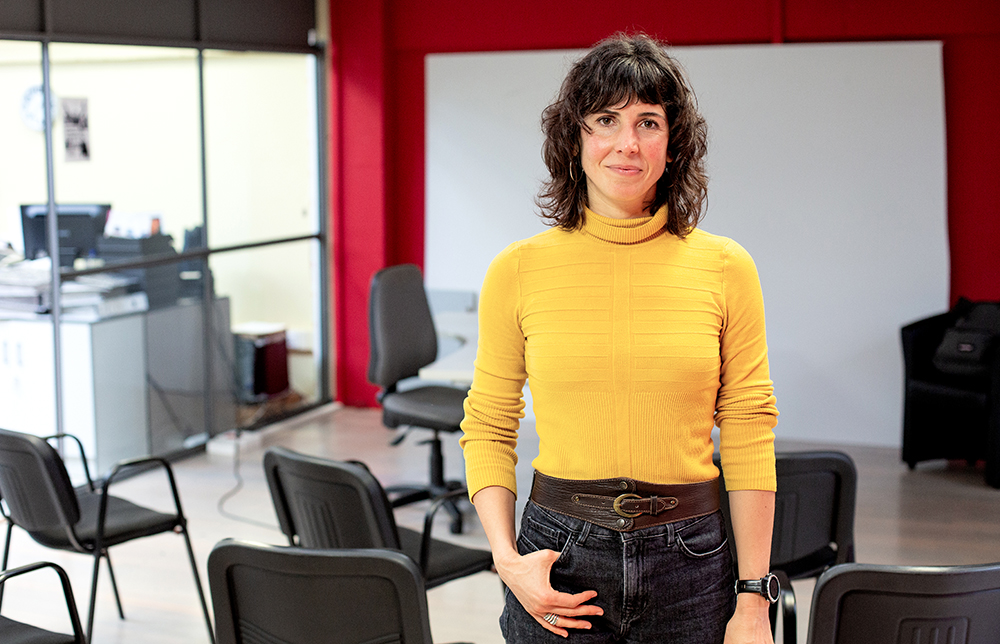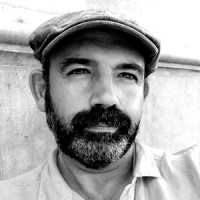Always marginal on the borders of the territory
- In March there was talk about the dialects of Auñamendi in Gasteiz within the cycle Hitz adina mintzo. Alberto Angos spoke about Roncalés at once and about Sulatino Argitxu Camus.

In both cases, the host Alberto Angos (Barakaldo, 1973) spoke first of the Roncalés, that is, of the eastern Navarro or of the wall of Auñamendi, at a time in the northeast of Navarre, with the limits of Aragon, Biarno and Zuberoa, in Basque. Angos recalled that the last language of the defiant was Fidela Bernat Aracues, of Uztárroz, and that, although the Basque language was used at the end of the 19th century throughout the Roncal valley, XX.aren at first the acquisition and loss of the language was evident. He pointed out that the sources of the bishopric of Pamplona from 1904 are a sample and proof of this and offered data.
Dialect lost
Angos, speaking of the causes of the loss, underlined several reasons and hypotheses. Geographical location was, however, one of the reasons for the loss, not the only one. It was linked to the opinion of Angos Bernardo Estornes Lasa, who partially attributed to the Second Carlist War the loss of language: “According to Estornes Lasa, most of the Roncalais were liberal, and when the Carlists appeared, many of them had to migrate to France or America. After the Carlist wars had ended, in 1876 the outbreaks were abolished and the protection of the borders to the carabine and to the genders increased”. These, obviously, belonged to the valley, which necessarily caused a conflict between Euskera and Castilian, as Angos pointed out: “However, as Antonia Anaut Garde de de Isaba and León Cebrián de Uztárroz said, the loss of the Basque Country was caused by the wealthy families of the people, who despised it. For Aunt Ubaldo Hualde, on the contrary, the centralism of the Spanish State was the main cause of the loss of the Basque language in Roncal, imposing the use of Spanish in schools and punishing children, both inside and outside the classroom, if spoken in Basque”. On the other hand, the Roncalan trades also influenced in part the use of the Basque Country, or in the loss: the transhumance of the pastors, which brought the works to the erdal villages, the carpentry, which attracted the workers of the valley area, and the spartry of Maule, to the extent that it led the women of the valley, were cited by Angos.
Classification
Having said this, Angos was associated with the appearance of the Basque dialect, pointing out that Prince Bonaparte had qualified Roncalés as a subdialect of Sulatino, “but in 1872, Études sur les trois dialectes basques des Vallées d’Aezcoa, de Salazar et de Roncal (in the book of Aezkoa, Salazar and Roncal). Bonaparte distinguished a roncalesa, three subdialects – those of Bidankoze, Urzainki and Uztárroz – and seven variants, taking as the main subdialect of Vidángoz. However, at this point Angos wanted to draw the public’s attention, emphasizing that Bonaparte’s two collaborators at Roncal were from Vidángoz: “Pedro Prudencio Hualde Mayo, Priest and Mariano Saturnino Mendigatxa Ornat, Campesino”.
The prince was not the only one who addressed the analysis of Roncalés, and Angos had other experts who analyzed the dialect: Azkue; Rudolf Trebischt; Juan José Beloki, Jesús Elosegi, Pilar Sansinenea Elosegi and Luis Mitxelena; Kandido Izagirre; Marcelino Garde; Juan San Martín; Estornes Lasa hermanos; Koldo Artola... Nevertheless, it is good to make a stop at Artola, which met and recorded its remains to the last challenge.
According to Angos, Koldo Artola met “Antonia Anaut de Isaba and Doroteo de Miguel de Uztárroz and Josefa Karrika. Antonia Anaut was a clean cut woman, while Doroteo de Miguel had distorted the Basque, who for years had been without speaking in Basque. As for Josefa Street, aged and with few words, Artola was hardly able to determine to what extent he knew he was able to break.” And, therefore, Alberto Angos gave the news of Fidela Bernat Arascues, the last speaker of Roncalés: “Koldo Artola met him in 1975, in Pamplona. Ten years earlier he moved to live with his family in the Navarre capital. Artola had a valuable informer, Fidela, who offered him a lot of interesting information about Euskera and life in the valley. Artola recorded Fidela in 1975 and 1978, and his Basque, like his cousin Doroteo, was already distorted.” It was, therefore, the fineness of the roncalés.
Putting an end to the intervention, Alberto Angos used the Roncalés' own texts, offering the listeners a kind of anthology. In them, Florencio Idoate read the oldest Roncalan texts written in Burgui in 1569, on the occasion of a trial of witchcraft: “Burgui, 8 September 1569. Aurrac, arnega eçaçuey jangueicoaz and Mariaz eta sayntu eta saynta guçoak eta andre dona Mariac eta santa Annac eztuey aurric. Catalina Bront, 7 years”.

To Zuber!
After talking to Roncalés Angos, Argitxu Camus Etxekopar (Onizepea, 1980), a professor and researcher recognized as a missionary of the Public Entity of the Basque Country, spoke in Suletino, divided into three sections. First he made the presentation of the region, continued with the situation and challenges of the Basque Country and held the session talking about the dialect.
Zuberoa is the most typical of the counties of the Basque Country, both by life and by territory. Located to the east, “it has Navarros neighborhoods, basonavarras and bearneses… It is a very important fact, as the neighborhood towns are very abundant in Zuberoa”. As a result, the different languages are intermingled in it, as Camus said.
Camus explained his historical, population and administrative knowledge, his municipalities and his cantonments, and explained some details about the socio-economic situation. We have a couple of pearls as an example. “Its main activity is agriculture and livestock, but its two major employers are hospitals, that is, hospitals for the elderly. This is very plausible to Zuberoa's dynamics and to the severe loss of people. That’s nothing new, because since World War II the population is coming down and it doesn’t stop.” The second curiosity, characteristic of culture: “Culturally, Zuberoa is very dynamic: there are pastoral, there are masked, there are lots of songs and spectacular…” And, as we know, this year is also expected to be pastoral in summer, in Ezpeiz.
From diglosis to diglosia
After this observation, Camus was associated with the situation of the Basque country. As you can see, the Sulatins speak Sulatino, but not all: “Five municipalities do not speak of Sulatins, but of labortano de navarra.” And already talking about the situation of the Basque Country, he departed from the data of the Socio-linguistic Survey: “We have figures from the Basque Country, Navarre and Iparralde, but we do not have our own numbers for Zuberoa, as in the survey we take Baja Navarra and Zuberoa together. However, in the last survey we know that in Iparralde 20% of us are Basques, while in the oldest section the percentage of Euskaldunes is also 50%”. It is obvious, however, that this figure will be reduced in the following surveys, starting from the older months. “There is work to be done: family transmission has stopped, and in this situation, the work that schools and Euskaltegis can do for the future is strategic, the key to truth,” he said, therefore, the weight in teaching.
Today there are also two ikastolas and bilingual schools in Zuberoa, but “at ikastolas, bilingual schools and at night schools, they teach the students to you and, in this sense, the challenges of suletino are those of the Basque Country.” There, as you can see, French has eaten most of the gas into our language. “The Basque Country is in a diglosic situation throughout the Basque Country, since French has clearly imposed itself on the Basque country. Euskera is developing through school, but more needs to be developed to recognize what has been lost.” Another thing, in Camus's mind: “Being a Sulatvian dialect, it is the farthest Basque from the one that regulated the batua, which has given it an additional diglossia. There’s a big challenge there,” not the only one, because Camus also defined something else.
Unable to clarify the black of the situation, he dedicated himself to the transmission of Euskera, pointing out the hardships: “In families, Euskera is transmitted little, the children do not listen to it in the street and, observing, we realize that there are problems to capture teachers who could teach in Suletino”… However, Camus had more challenges, how is the linguistic level of the student who is going to learn Euskera, that if the child does not listen Euskera at home, not even on the street outside the school. “What level will this child have?” Even in the Northern Basque Country, many boys and girls, even attending primary education in a bilingual model, tend to speak the second language to total French. “If they do not practice at home, not even on the street, because it seems they will lose the level of Euskera. I know you have those debates here too, yes, I know.” Camus referred not only to the umpteenth between knowledge and use, but also to the quality that this use entails.
Sin suletino, labortano de navarra
He then spoke about the future of the dialect, pointing to a large number of blacks: “The students who pass through the Ikastola learn in Suletino, but in Zuberoa it is no more than elementary, nor collegiate, they follow their studies in the Lartzabal of Baja Navarra, with a fungus, but not more in Suletino, but in Navarro, unified Iparralde”. For Camus, this also establishes a state of division between the unified and the Sulatino, which in turn will increase the evolution of the Sulatino itself. Because only the juice is taught in the ikastola, therefore the loss of toka and noka, and the children do not hear enough Sulatino – hence there are empty pronouncements, as the pronunciation of the hatxa, according to Camus – and, consequently, “the impoverishment of the dialect towards its disappearance can occur. That, however, is what the future is going to say, but I am rather pessimistic. I have many debates in the Public Institution of the Basque Country, I am told that the road is unified for the Euskaldunberris, but, excuse me, those who speak this way are manex – and the ‘manex’ is nothing pejorative – they are not Sulatins!” And Camus's annotation: “When the batua was made, it was based on a dialect and it was not yours. Not all languages are therefore in the same situation or in the same situation. They tell me that fighting for the dialects is not legitimate, which is the loss of strength, that the different dialects bring confusion to the Euskaldunberris. In my opinion, however, the dialects, the closest or the farthest from the unified Basque, are the Basque, part of the Basque DNA, and to lose them, to impoverish the Basque, it would be to weaken them, it will be another battle that the Basque will lose”.
1887. urtetik 1914. urtera almanaka bat zuberera hutsez argitaratu zen. Euskaltzaindiaren webgunera igo dituzte zenbaki guztiak PDF formatoan.
On 25 July of this year, four villages in Zuberoa — Ainharbe, Ezpeize-Ündürein, Sarrikotapea and Ürrüstoi-Larrabile — starred in the pastoral Abdelkader written by Jean-Louis Davant in the bounce square of the Ürrüstoi, one year after the terror of Covid.19. In fact,... [+]




















